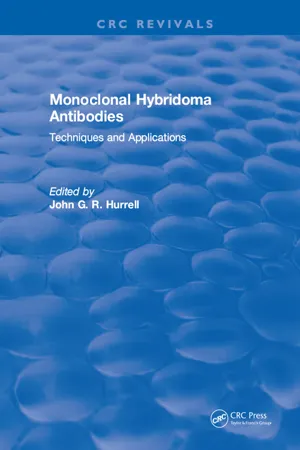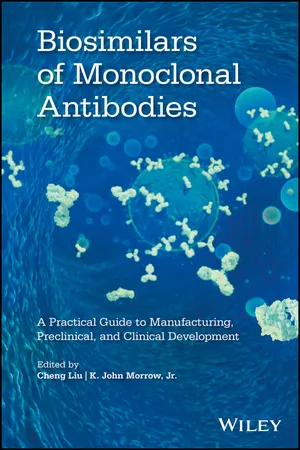Biological Sciences
Uses of Monoclonal Antibodies
Monoclonal antibodies are used in various applications, including targeted cancer therapy, diagnosis of infectious diseases, and treatment of autoimmune disorders. They can also be employed in research to detect specific proteins and study cellular processes. Their specificity and ability to bind to specific targets make them valuable tools in both clinical and research settings.
Written by Perlego with AI-assistance
Related key terms
3 Key excerpts on "Uses of Monoclonal Antibodies"
- eBook - ePub
- Maurizio Zanetti, Donald J. Capra(Authors)
- 1999(Publication Date)
- CRC Press(Publisher)
ChapterTHREE
Monoclonal Antibodies in Diagnosis, Prognosis, and Therapy of Human Carcinomas: Clinical Impact 20 Years Later
M. I. Colnaghi, S. Canevari, and S. Menard Division of Experimental Oncology E, Istituto Nazionale per lo Studio e la Cura dei Tumori, Via Venezian, 1,20133 Milano, ItalyINTRODUCTION
Monoclonal antibodies (MAbs) [1 ] were derived more than 20 years ago, but their relevance in the field of human cancer remains controversial since most mAbs have not behaved as expected, particularly in therapeutic approaches.The use of MAbs in cancer treatment/diagnosis progressed from a first generation of reagents in which the MAbs per se were the focus, to a second generation in which MAbs were conjugated with toxic molecules, and finally to a third generation in which the MAbs are often genetically engineered to achieve better targeting and fewer undesirable immunogenic effects.The hybridoma technology evolved [2 ] in parallel with the identification of new kinds of targets and a better understanding of the events that occur once the antibody binds to its target. Methods to derive cell lines that secrete a single species of antibody with the desired specificity have improved and extended by somatic cell genetics. More recently, new approaches have been proposed that bypass the need for hybridomas and even the need for immunized animals. Also, antibody affinity can now be changed by hypermutation of the original genes; rearranged variable (V) genes from single hybridoma cells or even single B lymphocytes can be rescued using “universal” primers and PCR, and desired V-gene combinations can be enriched by screening for functional antibody fragments that are expressed at the surface of phage through their binding to the relevant antigen [2 –4 ].Completely human MAbs have been developed to avoid the immunogenicity associated with rodent MAbs. Early efforts to “humanize” mAbs by linking murine variable regions and human constant regions [5 ] reduced rodent antibody immunogenicity but did not eliminate it entirely “Reshaped” antibodies were then generated, wherein the murine antigen-binding loops were grafted to human antibody [3 , 4 ]. However this approach is quite complex since the hypervariable loops must make the proper contacts with antigen, for which a large number of criteria must be met. Currently, two main approaches are used to create fully human MAbs. The first approach utilizes filamentous bacteriophage to display correctly folded functional antibody as scFv or Fab fragments. Human V genes are amplified by PCR using a mixture of primers for different V gene families to maximize the variability. Phage that display antibody fragments with the relevant specificity are selected by binding to solid-phase antigen, and the gene of interest is then recovered. Furthermore, selection to a specific epitope of an antigen can be “guided” if a murine antibody recognizing the epitope is available. The light chain of a murine MAb, directed against the relevant antigen, can be used to drive the selection of a VHCH1 human library expressed on phage. The human VHCH1 selected by panning is then paired with a repertoire of human light chain and, after further panning, a completely human Fab fragment is obtained that recognizes the same epitope as the murine antibody. The second approach is based on transgenic mouse technology, in which the mouse immunoglobulin gene loci are replaced with their human counterparts. This system provides the advantage of exploit the in vivo affinity maturation machinery of the mouse [6 - eBook - ePub
Monoclonal Hybridoma Antibodies
Techniques and Applications
- John G.R. Hurrell(Author)
- 2018(Publication Date)
- CRC Press(Publisher)
The specificity of the different antibodies already produced have assisted in the classification of lymphoid subpopulations in several diseases. The future will almost certainly expand their diagnostic possibilities. Experiments in mice suggest that the use of monoclonal antibody may allow nonspecific diagnosis and therapy of malignancies.Technology now available has also greatly facilitated the characterization of the lymphocyte populations to which the monoclonal antibody is directed. The cytofluorograph and the fluorescence activated cell sorter (FACS) have been invaluable in this regard.The rapid advances made in producing monoclonal antibodies to lymphocyte antigens have also resulted in a number of problems. Nomenclature and cross characterization of antibodies produced by different laboratories are among such difficulties. To allow better cross characterization between laboratories, an identical series of cells and cell extracts need to be tested with a broad spectrum of antibodies. Thus the monoclonal antibody should be tested against a series of normal lymphocytes, normal lymphocyte subpopulations, lymphoid cell lines of various types, lymphoid malignancies, and extracts of some or all of these cells to characterize the antigen involved physicochemically.What is required is the equivalent of the HLA workshops designed to evaluate new antilymphocyte antibodies and their reaction patterns. This will allow the direct comparison of one antibody with another. Useful antibodies to the various cell types can then be made available for experimental, diagnostic, and therapeutic use.REFERENCES1 . Singer, S. J. and Nicolson, G. L., The fluid mosaic model of the structure of cell membranes, Science, 175, 720, 1972.2 . Raff, M. C., Surface antigenic markers for distinguishing T and B lymphocytes in mice, Transplant Rev., 6, 52, 1971.3 . Cantor, H. and Boyse, E. A., Functional subclasses of T lymphocytes bearing different Ly antigens. I. The generation of functionally distinct T cell subclasses as a differentiative process independent of antigen, J. Exp. Med., 141, 1376, 1975.4 . Cantor, H. and Boyse, E. A. - eBook - ePub
Biosimilars of Monoclonal Antibodies
A Practical Guide to Manufacturing, Preclinical, and Clinical Development
- Cheng Liu, K. John Morrow(Authors)
- 2016(Publication Date)
- Wiley-Interscience(Publisher)
The generation of mAbs for the development of targeted treatments involves a variety of factors. Each targeted mAb therapy involves the choice of a disease‐specific target capable of generating an immune response. Chosen targets must be absent in healthy tissues or expressed only on noncrucial tissues in order to avoid toxicity and achieve clinical activity against a disease without further harming patients. Furthermore, mAbs must then be generated to specifically bind with high affinity to the chosen targets in order to prevent unpredictable outcomes such as toxicity or autoimmunity.A variety of techniques are involved in the design and production of mAbs. Designing mAbs involves both molecular cloning and recombination in order to enhance mAb stability and target affinity, achieve desirable immunogenicity, lower toxicity, and attain an overall beneficial clinical outcome for each patient. Currently, mAbs approved for patient use belong to the IgG family and are characterized by simple, linear PK profiles, small distribution volume, low clearance rates, and longer biological half‐lives in healthy subjects [5]. Often, the development and patient use of novel targeted treatments are hindered by steep research, production, and market costs. However, there are promising options for lowering mAb production costs through the use of yeast‐ or plant‐based systems.In this chapter, three main categories of human diseases were discussed including infectious, autoimmune, and neoplastic. Currently, mAb treatments for infectious diseases are not as advanced as those for neoplastic and autoimmune diseases. However, mAbs are currently being used to treat a variety of infectious diseases including RSV using palivizumab (a humanized anti‐F protein mAb) and anthrax with raxibacumab (a human recombinant anti‐PA mAb). Meanwhile, active research for creation of mAbs against diseases such as HIV and Ebola viruses is ongoing.
Learn about this page
Index pages curate the most relevant extracts from our library of academic textbooks. They’ve been created using an in-house natural language model (NLM), each adding context and meaning to key research topics.


